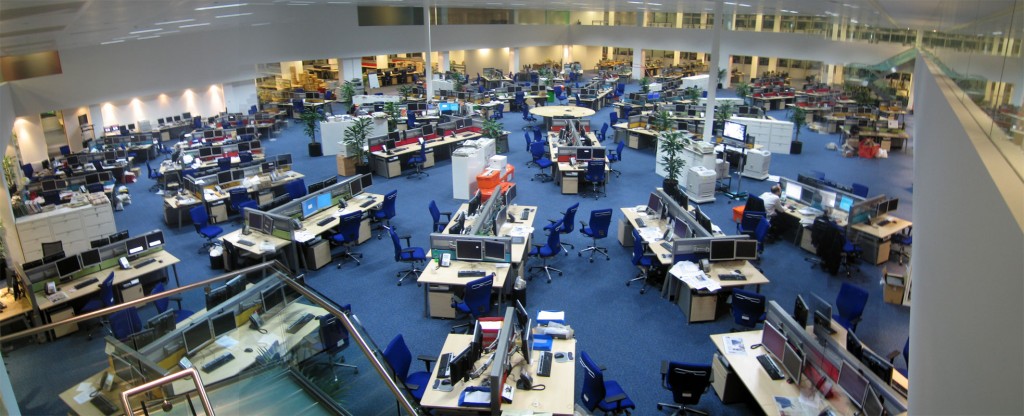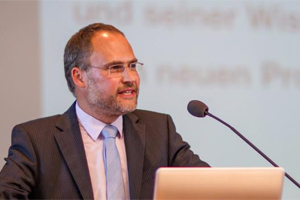Interview: New newsrooms mean more teamwork

CC image courtesy of victoriapeckham on Flickr
Many traditional newspaper publishers have completely restructured their newsrooms so that their print and online departments now work together. The way that they have done though varies enormously. In some, print and online journalists work side by side; in others, there is no distinction between the two departments at all.
Klaus Meier is a German media expert who has been closely observing exactly how media organizations are integrating their newsrooms. Together with researchers from Spain and Austria, Meier first published a detailed analysis of newsroom convergence in 2008. The team have done a follow up study this year.
DW Akademie’s Steffen Leidel talked to Klaus Meier about what newsrooms look like today and what these changes mean for the journalism of the future.
What are the main differences you found in how newsrooms are converging?
The fully integrated newsroom model completely brings together print and online as well as other digital platforms. It is also very strongly section orientated which means the sections determine the content for the various platforms. As such, the sections function as a type of central desk – they control the work flow, produce content across the various media and determine what goes online. An additional central desk is only for breaking news and news prioritizing.
In the cross-media model, online and print are strictly separated but cooperate closely. This cooperation is ultimately controlled by a highly integrated unit – which has various names such as the newsdesk, the multimedia manager or the multimedia editor. Their function is to see where and print and online can work together and how can they benefit from each other.
Social media tends to be used differently in the two models and this can help understand the difference. In the integrated model, it is the journalists themselves who use social media such as Twitter and Facebook to distribute their stories, collect comments and start discussions. In the cross-media model, it is very much the social media editor who coordinates this. Online journalists will be more likely to use social media and print journalists less likely but it is the social media editors who will have more say in this area.
In this day and age, does it make any sense to still differentiate between print and online journalists?
In the fully integrated model, distinctions between print and online are deliberately avoided and all journalists produce content for all platforms. That means journalists have to keep all of the possible platforms in mind when they are doing their stories and some of this content is then used to for the newspaper.
However, there are also good arguments for keeping a distinction between print and online. Online is a new medium that is rapidly developing and these developments require continuous innovation. It can be difficult to innovate though if staff are tied to meeting daily multiple deadlines. And therefore you could argue that you need to have online journalists who are not only on top of the latest developments but also have the time to stay on top of them so it is better for them to be able to act independently. If a newsroom doesn’t have an online unit, it at least should set up a research and development unit.
What skills do journalists need so that converged newsrooms function well?
It really depends on what kind of newsroom model you have. In the integrated model, ideally all journalists should know how to tell stories online, how to use all of the digital platforms and be proficient in using social media. In addition, journalists also need to be familiar with new technologies and software – for example, print journalists need to know how to use a video camera or how to tell stories using slideshows. In practice though, not all journalists have to be able do everything. Really what is important is finding a team that can cooperate to produce such stories.
So an integrated newsroom means more cooperation and more teamwork?
It’s been obvious for a long time that these new newsrooms require more teamwork. Previously, journalists were so-called “lonely riders” who researched stories and published them under their own byline. This idea of individual authorship is now being superseded by the idea of teamwork and openness. Newsrooms are becoming transparent in that journalists put all their materials into story folders that can be accessed by every other journalist in the newsroom. This idea that it’s a team which researches and exchanges ideas about stories is changing the work culture of journalism.
You’ve been involved in teaching journalism at university for many years. What do all these changes mean for journalism education and training?
That is something we’ve been discussing for many years. In the 1990s, for example, journalism students learned how to do radio and television but they learned these as two separate skills and not in cross-media projects. I think at the very beginning it is still necessary to learn the basic skills of each platform independently from other platforms. But then journalism training needs to incorporate a second step where students practice using these skills cross-medially – for example by telling a complex story in different ways. Because it is only by actually doing it that they get a sense of how to tell a story on various platforms and what type of content is appropriate for each platform.
Journalism schools seem to offer everything though at the moment, from data journalism and VJ training to social media management and community management. Do you have any tips for young journalists trying to decide what they should study?
I think students should know how to do a bit of everything but they have to decide for themselves what they would like to specialize in. There are still students out there who only want to work in TV. If that is the case, then we should make sure that they also know to write a good story for online and radio. So my advice would be to generalize at the beginning of your studies, have a go at everything and try to be proficient in all areas. But then decide where your speciality is and go deeper in story-telling for one platform.
What direction do you think the media is going to take in the future?
I think mobile journalism will develop rapidly in the next two to four years. For example, in Germany, one in five Internet users now has a tablet computer and two out of three have either a smartphone or a tablet, or both. This is an enormous potential market for innovative journalism products. And perhaps this will lead to new business models where users are prepared to pay more for media content. At the moment I am still skeptical about the apps on the market because most of them don’t offer a great deal of additional benefit to users compared to the open web. But I think there is great potential and we’ll see many new technical developments for new kinds of devices that are even easier to use, cheaper and more suitable for the mass market.
Technology is becoming increasingly important but media organizations are finding it difficult to have these kind of technology skills in house. What kind of difference is this making?
Newspaper publishers always used to have their technology – the printing press – under their roof. Now technology is outsourced and it’s the Internet providers and computer companies that are earning money with technology. That is a huge problem and I don’t have a solution. But newsrooms should have some kind of innovation or development department which is removed from the daily production schedule and which spends its time exploring the new devices coming out on the market and the kind of technology these devices use. So my advice is to bring journalists and technical developers together. And secondly, media organizations need to redevelop or renew their content management system so that they can use new media and diverse publication channels in a more flexible way.
 Dr Klaus Meier holds the chair for “journalism studies I” at the Catholic University Eichstätt-Ingolstadt in Germany. His research explores editorial management, innovations in newsrooms, convergence, online journalism, science journalism and journalism education.
Dr Klaus Meier holds the chair for “journalism studies I” at the Catholic University Eichstätt-Ingolstadt in Germany. His research explores editorial management, innovations in newsrooms, convergence, online journalism, science journalism and journalism education.




Feedback